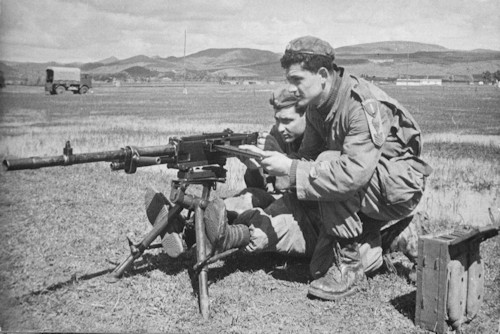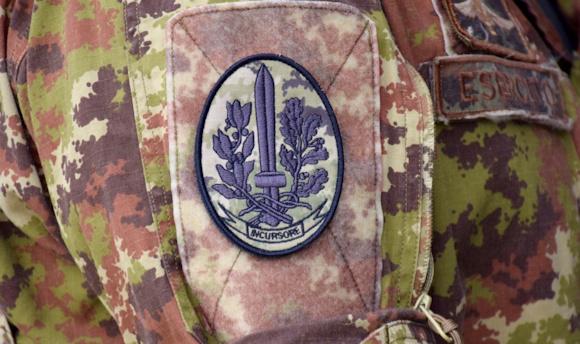The 9 ° assault regiment paratroopers With Moschin has taken another step towards the recovery of those traditions that founded the history of one of the most prestigious departments of the Italian army. On the occasion of the 40 anniversary of the formation of the Special Intervention Unit of the army it was announced that soon the Ninth will change the colors of its glorious Amaranth Basque to replace them with the "more traditional" gray-green ones that belonged to the first formation - the Special Platoon - born in the fifties.
In the 1952, a young paratrooper lieutenant, Franco Falcone, ventured the hypothesis of forming a small nucleus of soldiers specialized on the false line of the range divers of the second world war. His idea, initially accepted with some perplexity by both the army and the navy, became reality with the establishment of the first post-war special forces department, the "Special Plotone". This small group of scaglizzacollo was assigned, in April of 1953, to the Infantry School of Cesano and then transformed into a Paratrooper Saboteurs Company whose command was assigned to Captain Edoardo Acconci.
 At that time the saboteurs wore the gray-green beret, typical of Italian airborne troops, a direct legacy of the "folgorini" who had fought in the desert of El-Alamein, but also of the daring X battalion. The Basque with this shape was brought up to the Sixties, when the paratroopers brigade thunderbolt (mother unit in which the ninth was merged) adopted the amaranth headdress, a symbol that identified most of the paratroopers departments of the world. A choice that visually changed the uniform of those who opted to serve the homeland in the most severe, hard, but also more prepared army battalions.
At that time the saboteurs wore the gray-green beret, typical of Italian airborne troops, a direct legacy of the "folgorini" who had fought in the desert of El-Alamein, but also of the daring X battalion. The Basque with this shape was brought up to the Sixties, when the paratroopers brigade thunderbolt (mother unit in which the ninth was merged) adopted the amaranth headdress, a symbol that identified most of the paratroopers departments of the world. A choice that visually changed the uniform of those who opted to serve the homeland in the most severe, hard, but also more prepared army battalions.
The Ninth has always been "different" from the units that made it thunderbolt, a discrepancy resulting from the special training to which the first saboteurs were subjected and the later raiders. To belong to a great unity was, however, of mutual convenience: let us not forget that the Ninth owes it to the thunderbolt and viceversa. The spirit of sharing saboteurs / raiders, and the prodigarsi of its instructors has always been a point of pride for the Ninth regiment. The men of the With Moschin they have always worked closely with all branches of the army and thanks to the experience gained in the various operating contexts they have contributed to the improvement not only of the thunderbolt, but also all the other departments, including the Non-commissioned School and the Academy.
 Also on the level of traditions, the history of the Ninth stands out in front of any sector of special world forces; his direct descendants from the departments of the first world war constitute a unique, especially when compared to other better known but less elderly units, such as the British SAS oi Green caps Americans.
Also on the level of traditions, the history of the Ninth stands out in front of any sector of special world forces; his direct descendants from the departments of the first world war constitute a unique, especially when compared to other better known but less elderly units, such as the British SAS oi Green caps Americans.
From the sixties onwards the With Moschin began a journey aimed at the recovery of their origins: an operation certainly not easy and characterized by external prejudices, due to a military past that condemned the value of men to oblivion only to exalt their political affiliation. If there is one characteristic that distinguishes the raiders is their "hard head", ie to know how to struggle with obstinacy and commitment to achieve their goals. In this case - after several tortuous stages - the boys of the Ninth have achieved important results. From the war flag of the IX, to the black shields of the bold of Messe and lastly the new patent with the gladio recovered in the 2014.
Now, inaugurated the era of a new commander, the raiders add another piece of their history, adopting the gray-green cloth beret that was of their uncles in the fifties. An historical puzzle that is recomposed piece by piece, whose meaning does not mean variation or negation of what has happened to date; storing the Amaranth Basque is not, in fact, a choice aimed at disavowing the militancy in the thunderbolt to which all the raiders have always been morally united. Every soldier should have his origins well engraved in his mind: the periodic teaching of military history should have the same value as training with firearms. However, the Ninth never denies its preparation even in the historical field, knowing how to accept the nuances of every change, adapting to every circumstance, but with the mind always projected to the improvement not of the individual, but of the entire sector. These teachings do not need symbols, they do not need any recognition of cloth or metal, this is simply the character inherent in every raider who, with humility and dedication, teaches and never stops learning.
(photo: 9 ° regiment archive published in the volume "The Department. Past and present of the 9 Assault Regiment parachutists Col Moschin", Ed. Il Maglio 2016)












